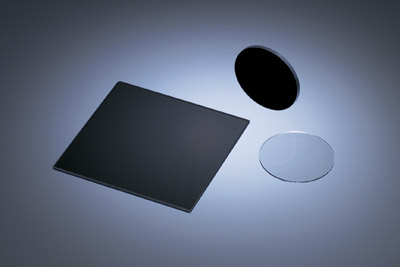
Neutral density (nd) filter: it can attenuate the light intensity. After passing through the neutral density filter, the light from the visible light region to the near-infrared light region will attenuate in the same proportion at different wavelengths, so that the optical elements maintain approximately equal light energy transmittance in the wide band. Also known as neutral density filter, neutral filter, ND filter, attenuator, fixed density filter, etc.
Neutral density (nd) filters are designed to uniformly reduce transmission over a portion of a particular spectrum. ND filter is usually defined by its optical density (OD), which describes the amount of energy blocked by the filter. High optical density values indicate very low transmittance, and low optical density values indicate high transmittance (equation 1-2). Nd filters can be stacked to achieve customized optical density. To calculate the final system OD, simply add the OD of each filter.

Example 1: if the filters of OD 0.3 and OD 1.5 are stacked together, what is the transmission?

Example 2: how to build a filter with a transmission rate of 0.5%?

Odtotal 2.3 can be superimposed by od0 3+OD2. 0 or od1 0+OD1. 3 create.
Type of neutral density filter
There are two types of Nd filters: reflection type and absorption type. Reflective ND filter is composed of thin film optical coating, usually metal coating, which has been applied to glass substrate. The coating can be optimized for a specific wavelength range, such as UV-Vis or NIR. The thin film coating mainly reflects light back to the light source. Special care should be taken to ensure that the reflected light does not interfere with the system settings. The absorption ND filter absorbs a specific percentage of light using a glass substrate.
Application fields of neutral density filter
Ultraviolet measuring instruments, various lasers, optical digital cameras, cameras, security monitoring, various optical instruments and equipment, optical communication attenuation filters, optical imaging systems, smoke meters, optical measuring instruments, near-infrared spectrometers, biochemical analysis equipment, etc.
Purpose of using neutral density filter
The main purpose of using nd mirror is to prevent overexposure. If the light is too bright, it is difficult to choose a slower shutter speed for shooting. At this time, using nd mirror to reduce the light entering the lens can use a slower shutter for shooting. For example, shooting with a slow shutter and strong water flow requires a longer exposure time, or shooting with a nd mirror under special conditions.
Special neutral gray mirror
Gradient mirror
The structure of this filter is that the lower part is a transparent lens, which gradually transitions upward to other colors, such as gradient gray, gradient blue, gradient red, etc. It can be divided into gradient mirror and gradient diffuse mirror. From the perspective of gradient form, it can be divided into soft gradient and hard gradient. “Soft” refers to a large transition range, otherwise it refers to a small transition range, which should be selected according to the creative characteristics. Gradient mirror is often used more in landscape photography. Its purpose is to deliberately make the upper part of the photo reach a certain expected tone in addition to ensuring the normal tone of the lower part of the photo.
Gray gradient mirror
Gray gradient mirror, referred to as GND mirror, is widely used in gradient mirror. It is half transparent and half light blocking, blocking part of the light entering the lens. It is mainly used to obtain the correct exposure combination allowed by the camera under the conditions of shallow depth of field photography, low-speed photography and strong light. It is also commonly used to balance the tone. GND mirror is used to balance the contrast between the top and bottom or left and right parts of the picture. It is often used to reduce the brightness of the sky and the contrast between the sky and the ground. In addition to ensuring the normal exposure of the lower part, it can effectively darken the brightness of the upper sky, soften the transition between light and shade, and effectively highlight the texture of clouds. GND mirror has different models and different grayscale. It gradually transitions from dark gray to colorless. It is usually decided to use it after measuring the contrast of the picture. It is exposed according to the photometric value of the colorless part, and some corrections are made if necessary.
Color gradient mirror
One of the most widely used color gradient mirrors is the sunset mirror, which is a transition from dark orange to light orange. It is used to enhance or create the effect of sunset and show the atmosphere of dusk in the shooting scene.
End



